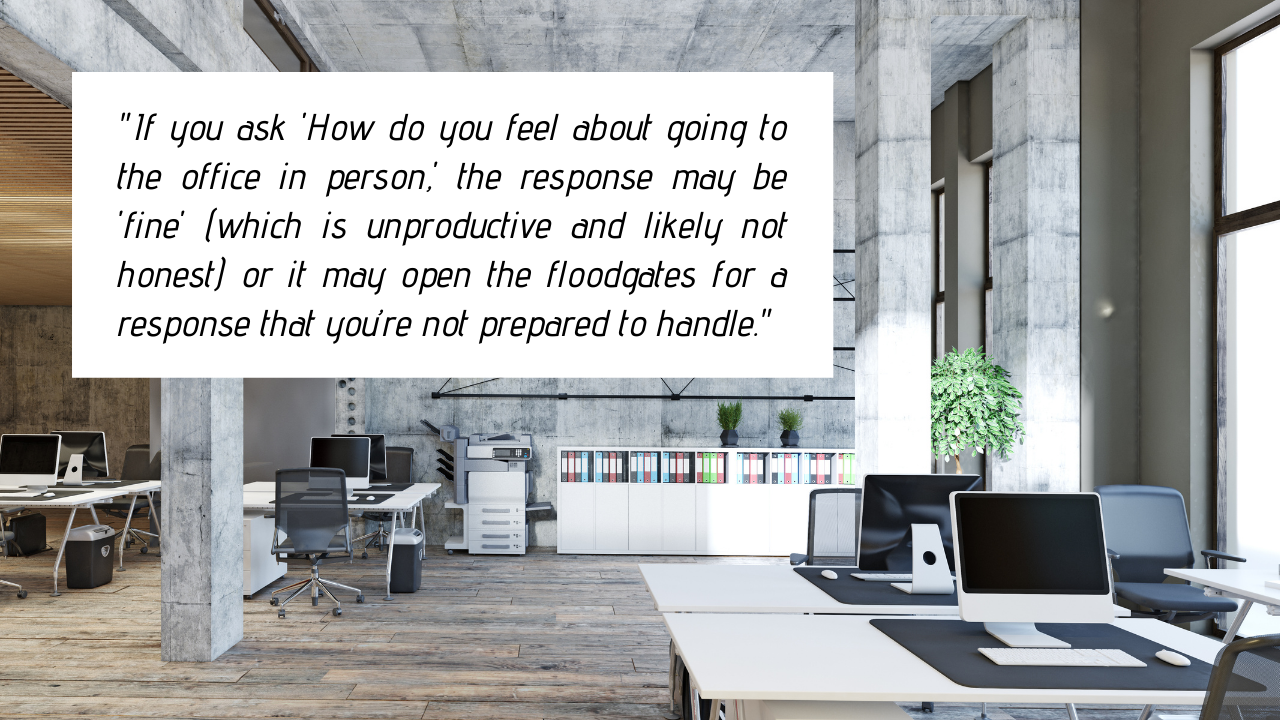How to support “pandemic-hires” joining the office

When employees are new to your organization, you know what you need to do to welcome and onboard them. Well, what about when they’ve been working for your company virtually for awhile, but now they’re transitioning to working in person? They’re not new...while still being new.
Returning to an in-person office environment is daunting for so many following the pandemic, but it may be especially challenging for those who were hired during the pandemic, because their concept of what their work “is” has been informed by the virtual experience. They’ve developed habits and figured out what relationships with colleagues are like in a virtual world. Like a word that has a strong connotation, there’s an underlying feeling about their work that’s hard to describe.
My belief is that it is your responsibility and in your organization’s best interest (let alone in the best interest of your relatively new colleague and yourself) to kindly and strategically facilitate their integration into the office. While there have long been instances of employees working remotely and then starting to work in an office, our current day is different because of the added stress of the pandemic.
How to Help Them
1. Determine how your colleagues truly feel
The only way to really know how they feel about going to the office for the first time despite having worked at your organization for awhile is to ask them — but you need to ask them in a way that invites an honest and productive response.
For instance, if you ask “How do you feel about going to the office in person,” the response may be “fine” (which is unproductive and likely not honest) or it may open the floodgates for a response that you’re not prepared to handle.
My recommendation is that you ask a question like “What are your top three concerns/questions about going to work in person?” That allows them to be specific (so no “fine”), it invites prioritized responses (so avoids the floodgates being opened), and it provides you with specific problems that you can attempt to address.
2. Flip their concerns to creative questions
Then flip their concern/question into a creative question. For instance, instead of “OK, what do you need to feel confident about arriving on your first day?” (which puts pressure on them to make an awkward ask in an under-informed situation) phrase it as “What are all the ways that we could help you feel confident about arriving on your first day?” Or, instead of “Alright, you’re worried about picking your child up from school on top when coming from the office. How can you fix that,” which shuts down the conversation and puts the burden entirely on them, try “How might you plan your day to accommodate working in the office and picking up your child on time?”
3. Generate ideas for their questions
If appropriate, help them generate as many ideas as possible. Encourage them to source ideas from many people with diverse perspectives. The wilder the idea, the better — because it is usually those stretch ideas that inspire ideas that are feasible and innovative.
Then have them narrow down on the idea(s) that best help them address their concerns.
4. Develop a plan, implement it, and optimize it
Encourage them to work through the plan. If their solution for adjusting their schedule to be able to be in the office and pick up their child on time is coming to work earlier, or shortening their lunch, or working an hour at night to make up for leaving an hour early, then they may need to figure out logistics with their partner, or to get approval from HR or their manager.
Have them test out their ideas, assuming there will still be some hiccups along the way. Then evaluate the plan and make it better!
Additional Considerations
The point of this process is to ask questions in a way that keeps minds open, since that is what generates better results and greater trust. A few closing suggestions include:
- Give them the benefit of the doubt. Just because they feel uncertain about returning to the office doesn’t mean that they’re not committed to their work. Try to empathize with them and understand their perspective.
- Don’t project your feelings on them. If you are nervous about the return to the office in person, don’t project those feelings on your new colleague — don’t assume that they have the same feelings as you, and vice versa.
- Making their uncertain return to the office smoother will pay off in the long run. The following Maya Angelou quotation captures that essence precisely: “people will forget what you said, people will forget what you did, but people will never forget how you made them feel.”
If you’d like to explore the concept of creative questions, you may want to start with this blog post: “An Uncommon Tool for a Common Problem,” which explores the power of the “How might we” question.
If you’d like help strategizing further, book a free consultation session with me!

Megan E. Mozina
Founder & Principal
Cresta Solutions
she/her


